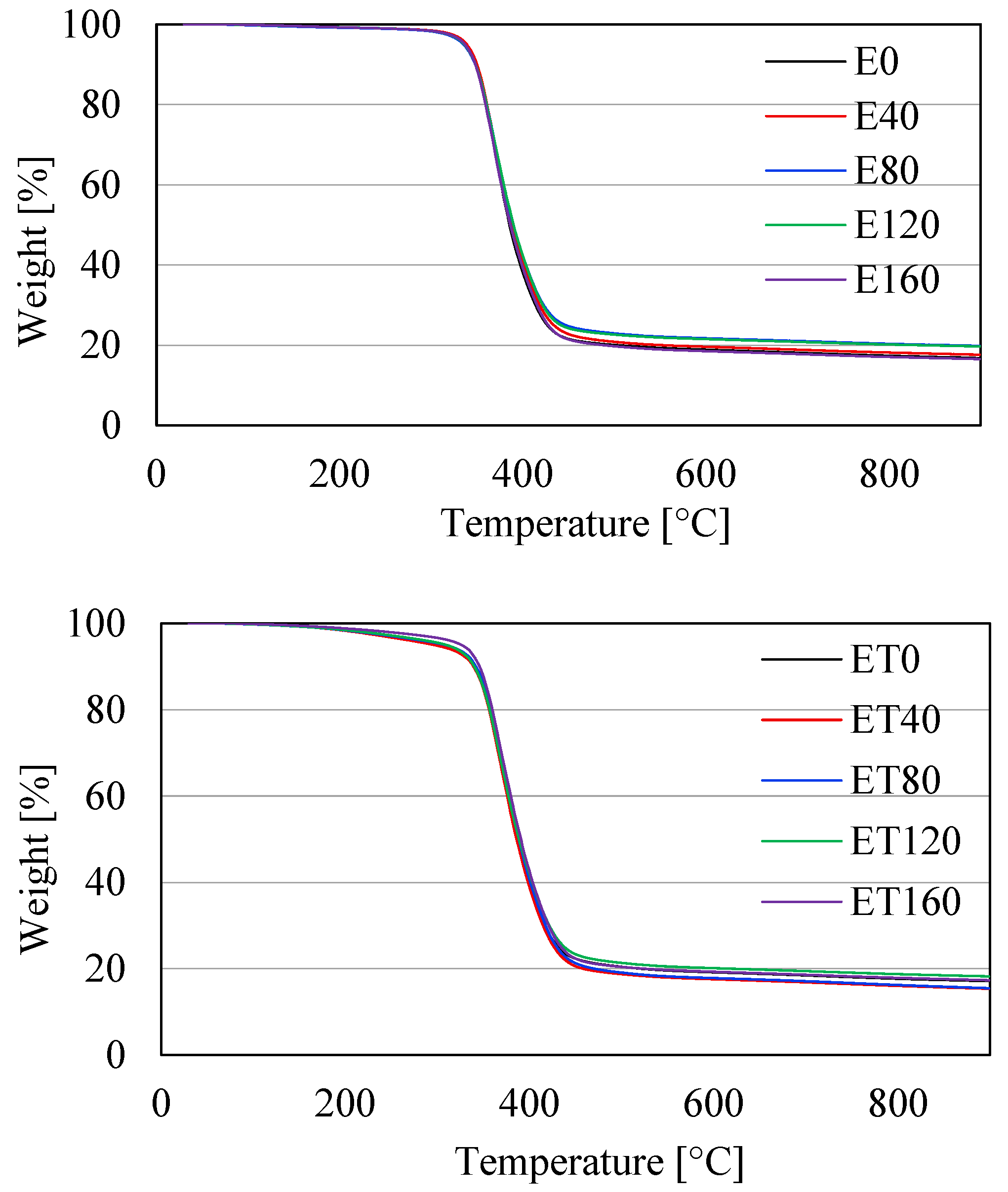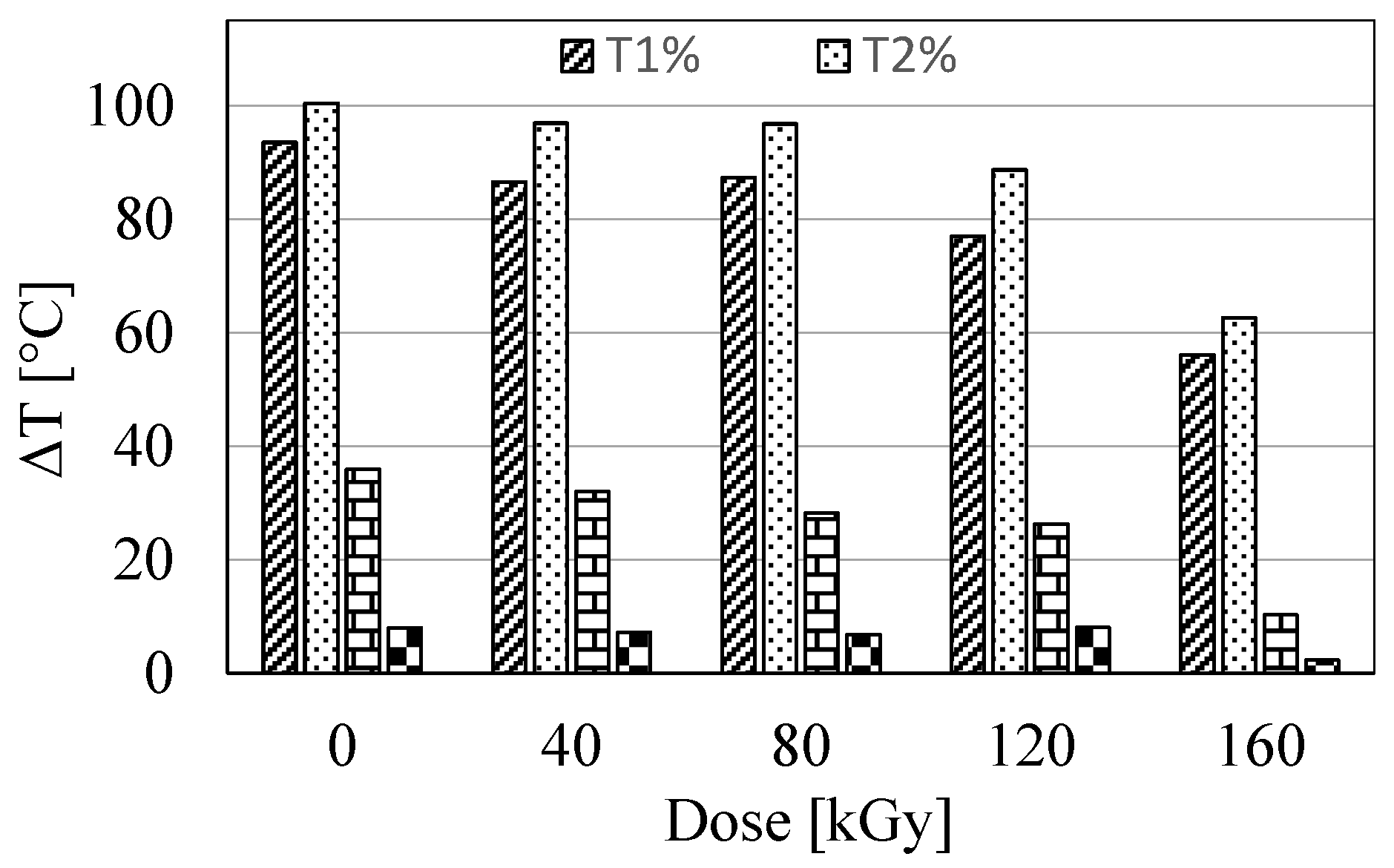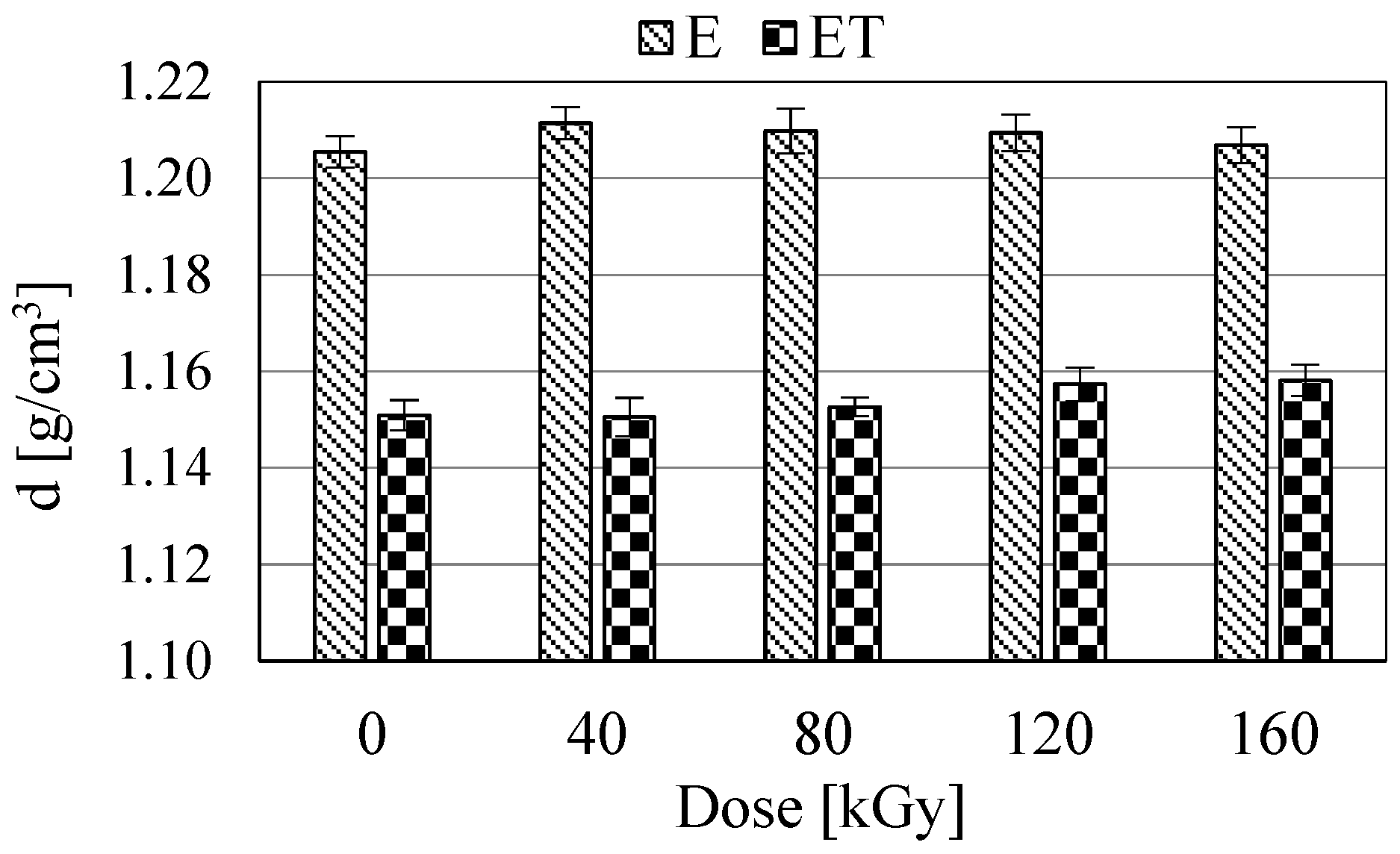Effect of Electron Radiation and Triallyl Isocyanurate on the Structure, Thermal, and Mechanical Properties of Epoxy Resin Filled with Dusty Fiber Fraction Derived from Recycled Wind Turbine Blades
Abstract
1. Introduction
2. Methodology
2.1. Materials
2.2. Apparatus
2.3. Sample Preparation
2.4. Research Methods
3. Results and Discussion
3.1. DSC Analysis
3.2. TG Analysis
3.3. Microscopic Investigations
3.4. Density
3.5. Mechanical Properties
3.5.1. Hardness
3.5.2. Three-Point Bending
3.5.3. Izod Impact Strength
4. Conclusions
Author Contributions
Funding
Data Availability Statement
Conflicts of Interest
References
- Boyano, A.; Lopez-Guede, J.M.; Torre-Tojal, L.; Fernandez-Gamiz, U.; Zulueta, E.; Mujika, F. Delamination fracture behavior of unidirectional carbon reinforced composites applied to wind turbine blades. Materials 2021, 14, 593. [Google Scholar] [CrossRef]
- Ding, A.; Wang, J.; Ni, A.; Li, S. Assessment on the ageing of sandwich composites with vinylester-based composite faces and PVC foam core in various harsh environments. Compos. Struct. 2019, 213, 71–81. [Google Scholar] [CrossRef]
- Rani, M.; Choudhary, P.; Krishnan, V.; Zafar, S. A review on recycling and reuse methods for carbon fiber/glass fiber composites waste from wind turbine blades. Compos. Part B 2021, 215, 108768. [Google Scholar] [CrossRef]
- Joustra, J.; Flipsen, B.; Balkenende, R. Structural reuse of high end composite products: A design case study on wind turbine blades. Resour. Conserv. Recycl. 2021, 167, 105393. [Google Scholar] [CrossRef]
- Rahimizadeh, A.; Kalman, J.; Fayazbakhsh, K.; Lessard, L. Recycling of fiberglass wind turbine blades into reinforced filaments for use in Additive Manufacturing. Compos. Part B 2019, 175, 107101. [Google Scholar] [CrossRef]
- Pickering, S.J. Recycling technologies for thermoset composite materials-current status. Compos. Part A 2006, 37, 1206–1215. [Google Scholar] [CrossRef]
- Pimenta, S.; Pinho, S.T. Recycling carbon fibre reinforced polymers for structural applications: Technology review and market outlook. Waste Manag. 2011, 31, 378–392. [Google Scholar] [CrossRef]
- Wei, Y.; Hadigheh, S.A. Development of an innovative hybrid thermo-chemical recycling method for CFRP waste recovery. Compos. Part B 2023, 260, 110786. [Google Scholar] [CrossRef]
- Jensen, J.P.; Skelton, K. Wind turbine blade recycling: Experiences, challenges and possibilities in a circular economy. Renew. Sustain. Energy Rev. 2018, 97, 165–176. [Google Scholar] [CrossRef]
- Mamanpush, S.H.; Li, H.; Englund, K.; Tabatabaei, A.T. Extruded fiber-reinforced composites manufactured from recycled wind turbine blade material. Waste Biomass Valorization 2020, 11, 3853–3862. [Google Scholar] [CrossRef]
- Beauson, J.; Laurent, A.; Rudolph, D.P.; Jensen, J.P. The complex end-of-life of wind turbine blades: A review of the European context. Renew. Sustain. Energy Rev. 2022, 155, 111847. [Google Scholar] [CrossRef]
- Sakellariou, N. Current and potential decommissioning scenarios for end-of-life composite wind blades. Energy Syst. Energy Syst. 2018, 9, 981–1023. [Google Scholar] [CrossRef]
- Beauson, J.; Madsen, B.; Toncelli, C.; Brøndsted, P.; Bech, J.I. Recycling of shredded composites from wind turbine blades in new thermoset polymer composites. Compos. Part A 2016, 90, 390–399. [Google Scholar] [CrossRef]
- Mamanpush, S.H.; Li, H.; Englund, K.; Tabatabaei, A.T. Recycled wind turbine blades as a feedstock for second generation composites. Waste Manag. 2018, 76, 708–714. [Google Scholar] [CrossRef]
- Correia, J.R.; Almeida, N.M.; Figueira, J.R. Recycling of FRP composites: Reusing fine GFRP waste in concrete mixtures. J. Clean. Prod. 2011, 19, 1745–1753. [Google Scholar] [CrossRef]
- Yazdanbakhsh, A.; Bank, L.C.; Tian, Y. Mechanical processing of GFRP waste into large-sized pieces for use in concrete. Recycling 2018, 3, 8. [Google Scholar] [CrossRef]
- Pławecka, K.; Przybyła, J.; Korniejenko, K.; Lin, W.T.; Cheng, A.; Łach, M. Recycling of mechanically ground wind turbine blades as filler in geopolymer composite. Materials 2021, 14, 6539. [Google Scholar] [CrossRef] [PubMed]
- Khalid, M.Y.; Arif, Z.U.; Hossain, M.; Umer, R. Recycling of wind turbine blades through modern recycling technologies: A road to zero waste. Renew. Energy Focus 2023, 44, 373–389. [Google Scholar] [CrossRef]
- Błędzki, A.; Urbaniak, M.; Adamcio, A.; Sobczyk, M.; Demski, S.; Boczkowska, A.; Seidlitz, H.; Köhler, M. Reusing and recycling of composite wind turbine blades. A review of current practices and prospects. Part 3. Various proposals offered by small and middle companies. Przem. Chem. 2024, 103, 241–250. [Google Scholar] [CrossRef]
- Smoleń, J.; Olesik, P.; Jała, J.; Adamcio, A.; Kurtyka, K.; Godzierz, M.; Kozera, R.; Kozioł, M.; Boczkowska, A. The use of carbon fibers recovered by pyrolysis from end-of-life wind turbine blades in epoxy-based composite panels. Polymers 2022, 14, 2925. [Google Scholar] [CrossRef]
- Cheng, X.; Du, B.; He, J.; Long, W.; Su, G.; Liu, J.; Fan, Z.; Chen, L. A Review of thermoplastic composites on wind turbine blades. Compos. Part B 2025, 299, 112411. [Google Scholar] [CrossRef]
- Chen, C.; Anderson, D.P. E-beam-cured layered-silicate and spherical silica epoxy nanocomposites. J. Appl. Polym. Sci. 2007, 106, 2132–2139. [Google Scholar] [CrossRef]
- Lopata, V.J.; Saunders, C.B.; Singh, A.; Janke, C.J.; Wrenn, G.E.; Havens, S.J. Electron-beam-curable epoxy resins for the manufacture of high-performance composites. Radiat. Phys. Chem. 1999, 56, 405–415. [Google Scholar] [CrossRef]
- Chen, J.H.; Johnston, A.; Petrescue, L.; Hojjati, M. Investigation of influence factors in electron beam curing of epoxy resins using a calorimetry technique. J. Appl. Polym. Sci. 2009, 111, 2318–2327. [Google Scholar] [CrossRef]
- Raghavan, J. Evolution of cure, mechanical properties, and residual stress during electron beam curing of a polymer composite. Compos. Part A 2009, 40, 300–308. [Google Scholar] [CrossRef]
- Kikkawa, J.; Nii, A.; Sakaniwa, Y.; Kon, N.; Sakamaki, M.; Ohashi, T.; Nita, N.; Harano, K.; Kimoto, K. Fast electron damage mechanism of epoxy resin studied by electron energy loss spectroscopy and electron diffraction. J. Chem. Phys. 2023, 159, 174708. [Google Scholar] [CrossRef]
- Cole, K.C.; Ton-That, M.T.; Johnston, A.; Hojjati, M.; Valcourt, K.; Lopata, V.J. Investigations into the mechanism of electron-beam curing of an epoxy resin. In Fourth Canada-Japan Workshop on Composites, 1st ed.; Hoa, S.V., Ed.; CRC Press: Boca Raton, FL, USA, 2002; pp. 43–52. [Google Scholar]
- Wolff-Fabris, F.; Altstädt, V. Electron Beam Curing of Epoxy Composites. In Epoxy Polymers: New Materials and Innovations, 1st ed.; Pascault, J.P., Williams, R.J.J., Eds.; Wiley-VCH: Weinheim, Germany, 2010; pp. 253–269. [Google Scholar]
- Kang, P.H.; Park, J.S.; Nho, Y.C. Effect of electron beam and γ-ray irradiation on the curing of epoxy resin. Macromol. Res. 2002, 10, 332–338. [Google Scholar] [CrossRef]
- Sui, G.; Zhong, W.H.; Yang, X.P. The revival of electron beam irradiation curing of epoxy resin—Materials characterization and supportive cure studies. Polym. Adv. Technol. 2009, 20, 811–817. [Google Scholar] [CrossRef]
- Sui, G.; Zhang, Z.G.; Chen, C.Q.; Zhong, W.H. Analyses on curing process of electron beam radiation in epoxy resins. Mater. Chem. Phys. 2003, 78, 349–357. [Google Scholar] [CrossRef]
- Cong, L.; Guo, Z.; Zhang, X.; Li, H.; Jiang, H.; Jing, Y.; Yan, J.; Li, W.; Jang, J.; Li, X. Effect of Electron Beam Irradiation on the Percentage Loss of Tensile Modulus of Epoxy Polymer. Polymers 2025, 17, 447. [Google Scholar] [CrossRef] [PubMed]
- Nishitsuji, D.A.; Marinucci, G.; Evora, M.C.; e Silva, L.G.D.A. Study of electron beam curing process using epoxy resin system. Nucl. Instrum. Methods Phys. Res. Sect. B 2007, 265, 135–138. [Google Scholar] [CrossRef]
- Dyakonov, T.; Chen, Y.; Holland, K.; Drbohlav, J.; Burns, D.; Vander Velde, D.; Seib, L.; Soloski, E.J.; Kuhn, J.; Mann, P.J.; et al. Thermal analysis of some aromatic amine cured model epoxy resin systems—I: Materials synthesis and characterization, cure and post-cure. Polym. Degrad. Stab. 1996, 53, 217–242. [Google Scholar] [CrossRef]
- Malinowski, R.; Rytlewski, P.; Janczak, K.; Raszkowska-Kaczor, A.; Moraczewski, K.; Stepczyńska, M.; Żuk, T. Studies on functional properties of PCL films modified by electron radiation and TAIC additive. Polym. Test. 2015, 48, 169–174. [Google Scholar] [CrossRef]
- Rusli, A.; Raffi, N.S.M.; Ismail, H. Solubility, miscibility and processability of thermosetting monomers as reactive plasticizers of polyetherimide. Procedia Chem. 2016, 19, 776–781. [Google Scholar] [CrossRef][Green Version]









| Dose [kGy] | Composite E | Composite ET |
|---|---|---|
| EP5/Z1 + DF (4 to 1 Ratio by Weight) | EP5/Z1/DF + TAIC (19 to 1 Ratio by Weight) | |
| 0 | E0 | ET0 |
| 40 | E40 | ET40 |
| 80 | E80 | ET80 |
| 120 | E120 | ET120 |
| 160 | E160 | ET160 |
| Sample | Tg1 [°C] | Tg2 [°C] | Tc-l [°C] | ΔH [J/g] |
|---|---|---|---|---|
| E0 | 59.6 | 98.6 | 109.5 | 31.2 |
| E40 | 60.7 | 118.9 | 110.5 | 35.8 |
| E80 | 62.2 | 119.1 | 112.2 | 30.5 |
| E120 | 62.6 | 120.6 | 110.1 | 29.1 |
| E160 | 63.3 | 120.6 | 111.0 | 32.5 |
| ET0 | 58.5 | 93.4 | 114.6 | 26.0 |
| ET40 | 59.8 | 98.3 | 114.9 | 25.7 |
| ET80 | 61.1 | 100.4 | 116.2 | 24.3 |
| ET120 | 61.7 | 102.9 | 116.8 | 29.7 |
| ET160 | 62.1 | 104.5 | 116.8 | 26.0 |
| Sample | T1% [°C] | T2% [°C] | T5% [°C] | T10% [°C] | Tmax. [°C] |
|---|---|---|---|---|---|
| E0 | 266.1 | 317.3 | 339.0 | 349.8 | 374.1 |
| E40 | 259.2 | 314.2 | 337.8 | 348.4 | 375.7 |
| E80 | 257.0 | 313.3 | 337.1 | 348.7 | 372.0 |
| E120 | 248.7 | 309.6 | 336.3 | 348.3 | 372.4 |
| E160 | 246.2 | 310.5 | 336.6 | 348.2 | 370.1 |
| ET0 | 172.6 | 216.9 | 303.1 | 341.8 | 368.4 |
| ET40 | 172.7 | 217.3 | 305.8 | 341.2 | 374.9 |
| ET80 | 169.7 | 216.5 | 308.9 | 341.9 | 367.7 |
| ET120 | 171.7 | 220.9 | 310.0 | 340.2 | 371.6 |
| ET160 | 190.1 | 247.9 | 326.3 | 345.9 | 369.1 |
| Sample | σfM [MPa] | s [mm] | Ef [MPa] |
|---|---|---|---|
| E0 | 52.5 | 2.01 | 4039 |
| E40 | 54.3 | 2.05 | 3976 |
| E80 | 57.1 | 2.16 | 3979 |
| E120 | 54.0 | 2.02 | 3951 |
| E160 | 52.3 | 1.99 | 3757 |
| ET0 | 50.7 | 2.22 | 3687 |
| ET40 | 48.9 | 2.17 | 3762 |
| ET80 | 53.1 | 2.33 | 3764 |
| ET120 | 52.4 | 2.15 | 3817 |
| ET160 | 51.7 | 1.98 | 3888 |
Disclaimer/Publisher’s Note: The statements, opinions and data contained in all publications are solely those of the individual author(s) and contributor(s) and not of MDPI and/or the editor(s). MDPI and/or the editor(s) disclaim responsibility for any injury to people or property resulting from any ideas, methods, instructions or products referred to in the content. |
© 2025 by the authors. Licensee MDPI, Basel, Switzerland. This article is an open access article distributed under the terms and conditions of the Creative Commons Attribution (CC BY) license (https://creativecommons.org/licenses/by/4.0/).
Share and Cite
Malinowski, R.; Matykiewicz, D.; Krasinskyi, V.; Gryczka, U.; Kaczor, D. Effect of Electron Radiation and Triallyl Isocyanurate on the Structure, Thermal, and Mechanical Properties of Epoxy Resin Filled with Dusty Fiber Fraction Derived from Recycled Wind Turbine Blades. Fibers 2025, 13, 150. https://doi.org/10.3390/fib13110150
Malinowski R, Matykiewicz D, Krasinskyi V, Gryczka U, Kaczor D. Effect of Electron Radiation and Triallyl Isocyanurate on the Structure, Thermal, and Mechanical Properties of Epoxy Resin Filled with Dusty Fiber Fraction Derived from Recycled Wind Turbine Blades. Fibers. 2025; 13(11):150. https://doi.org/10.3390/fib13110150
Chicago/Turabian StyleMalinowski, Rafał, Danuta Matykiewicz, Volodymyr Krasinskyi, Urszula Gryczka, and Daniel Kaczor. 2025. "Effect of Electron Radiation and Triallyl Isocyanurate on the Structure, Thermal, and Mechanical Properties of Epoxy Resin Filled with Dusty Fiber Fraction Derived from Recycled Wind Turbine Blades" Fibers 13, no. 11: 150. https://doi.org/10.3390/fib13110150
APA StyleMalinowski, R., Matykiewicz, D., Krasinskyi, V., Gryczka, U., & Kaczor, D. (2025). Effect of Electron Radiation and Triallyl Isocyanurate on the Structure, Thermal, and Mechanical Properties of Epoxy Resin Filled with Dusty Fiber Fraction Derived from Recycled Wind Turbine Blades. Fibers, 13(11), 150. https://doi.org/10.3390/fib13110150








